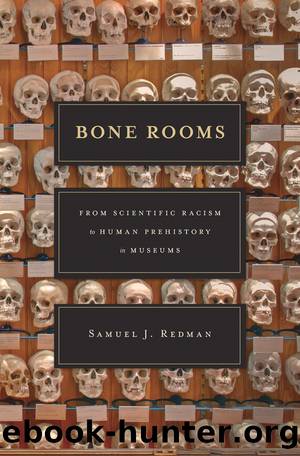Bone Rooms by Samuel J. Redman

Author:Samuel J. Redman [Redman, Samuel J.]
Language: eng
Format: epub
Tags: Science, History, Social Science, Anthropology, General, United States
ISBN: 9780674660410
Google: dA28jgEACAAJ
Publisher: Harvard University Press
Published: 2016-03-14T16:11:15+00:00
AMERICAN MUSEUM OF NATURAL HISTORY
Sometime in the early 1920s, curator Clark Wissler penned a brief description of the physical anthropology collections at the American Museum of Natural History (AMNH) in New York. Wisslerâs manuscript offers a glimpse as to how collections were brought together and studied during this period at one of the largest museums in the nation. The document begins by noting that the collections of the AMNH contained over twenty-one hundred human crania. The emphasis on skulls was the result of several influencing factors. First, building on traditions ranging from phrenology to medicine and anthropology, scientists continued to believe that the human skull held clues to answering the most important questions about race and human history.16 Skulls were also more durable and easily transported than other body parts; smaller, more fragile bones, although still prized for museum collections, were often lost, broken, or sometimes even simply discarded. Two large collections made up a sizable portion of the total number of crania at the museum; Eskimo crania accounted for 350 items in the total collection, and nearly another 250 were brought to New York from the American Southwest.
Apart from the human skulls of North America, the largest number at the AMNH originated from South America, with an additional 600 crania from Bolivia and Peru and another 350 from Mexico. The museum featured a smattering of remains from other regions around the world, listing â2 Pygmies, 3 Australians, 2 Japanese, and 1 New Zealander.â17 Although race had been the defining factor driving the actual collecting of human remains for the previous fifty years, remains were sometimes classified internally by region or geography and were increasingly so with the passing decades and changing scientific and intellectual milieu.
Although HrdliÄka visited the AMNH to study Eskimo skulls, Wissler notes that, at that time, the vast majority of the cranial collections in New York remained unstudied.18 Wisslerâs description did not identify any mummified remains from Egypt, though collectors from the United States and Europe were still actively buying, and subsequently donating, mummies. Though the manuscript hints at the prehistoric nature of some remains, it briefly organizes them by region or race rather than making any sort of claim about the age of the specimens. Within a decade of the circulation of the memorandum, however, the emphasis of many major museums in describing their human remains collections changed. Race was the major qualifier for human remains early in the 1920s, but reinvigorated interest in human prehistory reshaped how remains were conceptualized in museum collections in the United States in later years. Mirroring the emphasis on race found in the AMNHâs description of its own collections was work in the field of anthropometry.
Download
This site does not store any files on its server. We only index and link to content provided by other sites. Please contact the content providers to delete copyright contents if any and email us, we'll remove relevant links or contents immediately.
Born to Run: by Christopher McDougall(7064)
The Leavers by Lisa Ko(6910)
iGen by Jean M. Twenge(5366)
Sapiens by Yuval Noah Harari(5293)
The Kite Runner by Khaled Hosseini(5081)
Spare by Prince Harry The Duke of Sussex(5071)
Machine Learning at Scale with H2O by Gregory Keys | David Whiting(4169)
Bullshit Jobs by David Graeber(4094)
Never by Ken Follett(3787)
Goodbye Paradise(3724)
Livewired by David Eagleman(3682)
Fairy Tale by Stephen King(3216)
A Dictionary of Sociology by Unknown(3016)
Harry Potter 4 - Harry Potter and The Goblet of Fire by J.K.Rowling(2984)
The Social Psychology of Inequality by Unknown(2936)
The Club by A.L. Brooks(2862)
Will by Will Smith(2788)
0041152001443424520 .pdf by Unknown(2783)
People of the Earth: An Introduction to World Prehistory by Dr. Brian Fagan & Nadia Durrani(2701)
